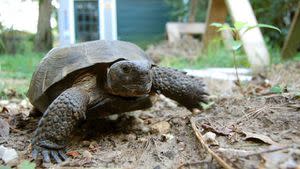US: Gopher tortoise not threatened over most of its range

Gopher tortoises — burrowers whose extensive homes shelter many other animals — are generally doing well and need federal protection only in the small area where they were declared threatened 35 years ago, the government said Tuesday.
Thanks to extensive conservation work and recently discovered populations, Georgia’s state reptile is no longer a candidate for protection in the bulk of its range: Florida, south Georgia, most of coastal Alabama and a sliver of South Carolina, the U.S. Fish and Wildlife Service said.
An environmental group which sued for protection across the entire range called the decision indefensible.
“It ignores devastating urban sprawl that’s decimated the tortoise’s habitat and will continue to drive the species ever closer to extinction,” said Elise Bennett, Florida director and an attorney at the Center for Biological Diversity.
The National Alliance of Forest Owners, on the other hand, called the agency’s action a great decision that recognizes the success of voluntary conservation programs.
>>> STREAM ACTION NEWS JAX LIVE <<<
“More than just this single listing, this story is also about the success of a new approach to conservation,” spokesman Ethan Breitling said.
The Fish and Wildlife Service said small, disconnected populations remain threatened in southeastern Mississippi and bits of Louisiana and Alabama, which together make up about 12% of the tortoise’s range.
“Efforts to improve conditions for the gopher tortoise have been effective, and it is important that scientists, experts and wildlife professionals continue to strategically use our best resources to help recover the gopher tortoise where it’s most vulnerable,” Leopoldo Miranda-Castro, the service’s southeastern regional director, said in a news release.
Although gopher tortoises average 9 to 11 inches (23 to 28 centimeters) long, researchers have found burrows up to 40 feet (12 meters) long. More than 360 kinds of animals have been found in occupied or abandoned burrows; the 60 vertebrate species include dusky gopher frogs,eastern indigo snakes and burrowing owls.
Logging and development are two of the gopher tortoise’s biggest threats. It lives in sandy upland forests with widely spaced trees, including longleaf pine savannas that once covered an area larger than Germany. Those once-extensive forests are now down to about 5% of that area.
[DOWNLOAD: Free Action News Jax app for alerts as news breaks]
Longleaf pine restoration, however, is among many programs that have helped gopher tortoises, the Fish and Wildlife Service said.
Gopher tortoises were among more than 500 species listed in 2011 as possibly needing protection to settle lawsuits brought by two environmental nonprofits, Arizona-based Center for Biological Diversity and New Mexico-based WildEarth Guardians.
Bennett said Tuesday that the decision was made even though the federal agency expects populations to decline range-wide over the next 80 years — with the largest drops in Florida and the western part of its range.
She said the group is studying the decision and considering all options including another lawsuit.
[SIGN UP: Action News Jax Daily Headlines Newsletter]
“State programs, particularly in Florida — the heart of their range — are just not working,” she said Friday, as the federal deadline approached. “Florida is largely just moving them out of areas under development and into smaller and smaller habitat. And fragmentation is a problem already.”
The federal statement said Florida has 50 long-term relocation sites covering more than 120 square miles (310 square kilometers) of gopher tortoise habitat.
Many populations in the nearly 109,700-square-mile (284,100-square-kilometer) eastern area are in good condition despite threats that include climate change and sea-level rise as well as habitat loss and fragmentation, the federal agency said.
“Future projections ... show that many healthy populations will remain across the range,” it said.
In the 15,000-square-mile (39,000-square-kilometer) western section, though, populations are smaller and reproduction is lower, and they have a low ability to rebound from population or environmental changes, the agency said.
The Fish and Wildlife Service said gopher tortoises currently live on about 161 square miles (417 square kilometers) of the area and are threatened — not endangered.
“Because gopher tortoises are long-lived, they will remain on the landscape for several decades despite current and ongoing threats,” it said.
Click here to download the free Action News Jax news and weather apps, click here to download the Action News Jax Now app for your smart TV and click here to stream Action News Jax live.
